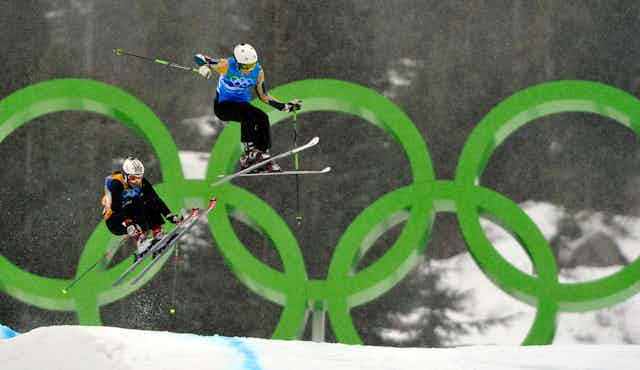Some of the most exciting moments in the Sochi Winter Olympics will be in racing events such as ski and snowboard cross and short track speed skating.
While it may seem obvious that vision plays a big role in determining where athletes go and how they keep track of all the things going on around them, it may be less obvious that small differences in how athletes use their eyes to guide themselves around the course can make the difference between a gold medal and finishing off the podium.
Watch where you’re going!
The high-speed environments that athletes race through are incredibly demanding regardless of whether an athlete is racing against the clock (such as downhill skiing and speed skating) or against competitors (such as ski cross).
Research in driving and walking have generally shown that people look in the direction that they want to go – they look ahead, rather than at their feet.
When going around a bend, which is necessary for many of the racing events at the Olympics, where a person looks can influence the line they take through the bend and looking to the inside of the turn is associated with selecting the quickest path, or racing line (which means faster race times!).
Taking it to the track
Sport scientists have begun to apply this knowledge and measure the eye movements of athletes in a variety of sporting events. Using state-of-the-art, mobile eye tracking technology, we can measure the eye movements of athletes as they compete in the real world.
While it’s no easy feat (think cold, snow, and waiting hours on end in the lodge for weather to clear), we have adapted the technology to allow us to record the eye movements of Australian ski cross athletes while they perform training runs on the track by fitting the eye tracker into a pair of ski goggles.

This type of technology provides a look into how athletes use vision to navigate the course. We can judge the importance of different areas by measuring the amount of time spent looking at them.
By recording the gaze of athletes in their natural environment we’re given a rare glimpse into the visual strategies they use to control their actions, how they deal with unexpected events (a competitor suddenly appearing from behind them) and which type of visual strategies lead to faster race times.

In speed skating, my colleague Joan Vickers had the unique opportunity to measure the gaze behaviour of some of the world’s fastest athletes on ice.
By recording gaze behaviour while athletes raced around the track, she was able to see how focusing on different locations through the turn affected lap times.
Much like the findings from studies on driving, she found that skaters had faster lap times (by almost 2.5 seconds) when they looked at the spot where the inside turn changes direction.
Training the eyes
In events such as the Winter Olympics, where athletes are already in peak physical condition, the ability to find other aspects of performance that set them apart is crucial – and eye movements might be one of the keys.
By identifying the critical gaze behaviours that lead to better performance and by comparing differences between expert and developing, or novice, athletes, sport scientists and coaches can develop training strategies to help athletes look at places within the race environment that lead to faster race times.
This emerging area of research has already shown that performance can be improved by teaching novices to use the visual strategies of experts in a number of areas including basketball, golf putting, rifle shooting and even surgery.
As technology and our understanding of gaze behaviour continue to improve we may be able to identify and train the next Olympic gold medallist by measuring what – and where – they see!

